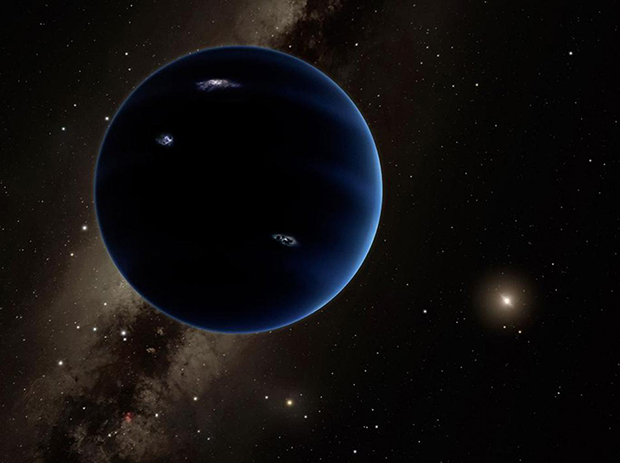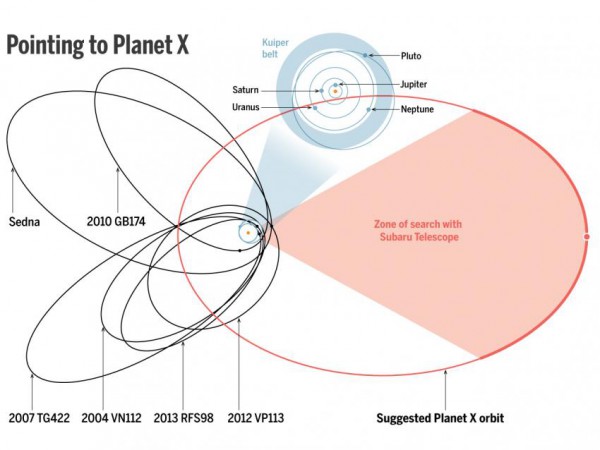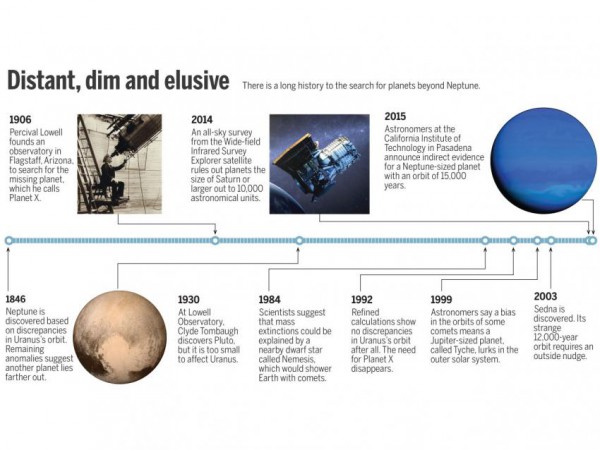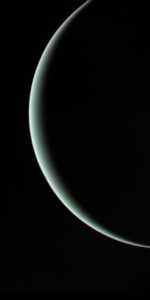
For a long time now, there have been theories and rumors regarding the possible existence of another planet in our Solar System, far beyond Neptune or even Pluto, often referred to as “Planet X.” Unfortunately, there has been little hard evidence to back up any claims made. But now, new evidence has been presented by astronomers at Caltech which increases the likelihood of another, and fairly large, distant planet in the far outer reaches of the Solar System. How does this compare to other discovery claims for Planet X?
If confirmed, the new planet, dubbed “Planet Nine” for the time being, would have a mass about 10 times that of Earth and orbit 20 times farther from the Sun than Neptune, on average. Since Neptune has an average orbit of 2.8 billion miles from the Sun, that is a long way out indeed; it would take this planet between 10,000 and 20,000 years to complete just one orbit. With an estimated radius of two to four times that of Earth, the planet’s size might make it comparable to “super-Earth” exoplanets which have been found orbiting many stars now—significantly larger than Earth, but smaller than Neptune or Uranus.
The new evidence, presented by researchers Konstantin Batygin and Mike Brown, comes from mathematical modeling and computer simulations at this point. Even at its large size, it will be difficult to see it visually, since it’s so far from the Sun.

“This would be a real ninth planet,” said Brown, the Richard and Barbara Rosenberg Professor of Planetary Astronomy. “There have only been two true planets discovered since ancient times, and this would be a third. It’s a pretty substantial chunk of our Solar System that’s still out there to be found, which is pretty exciting.”
Their findings are in the new paper “Evidence for a Distant Giant Planet in the Solar System,” which is in the current issue of the Astronomical Journal. The two researchers admit to initial skepticism about their discovery.
“Although we were initially quite skeptical that this planet could exist, as we continued to investigate its orbit and what it would mean for the outer solar system, we become increasingly convinced that it is out there,” said Batygin, an assistant professor of planetary science. “For the first time in over 150 years, there is solid evidence that the solar system’s planetary census is incomplete.”
As Brown also surmised in Nature, “If I read this paper out of the blue, my first reaction would be that it was crazy,” says Mike Brown, an astronomer at the California Institute of Technology in Pasadena, who was part of the research team. “But if you look at the evidence and statistics, it’s very hard to come away with any other conclusion.”
It is being referred to as the ninth planet, since poor Pluto had been demoted to dwarf planet status, leaving only eight “real” planets, which does not sit well with a lot of people who still believe that Pluto should be classified as a proper planet, not just a mini-version of one. As most people know, that has evolved into a long-running and contentious debate in itself—and not just Pluto, also other similar-sized worlds like Ceres and Sedna. That feeling was summarized rather nicely by Mike Wrathhell in a Facebook post for the Society of Unapologetic Pluto Huggers:
“As Alan Stern said, ‘There is no discovery.’ It is disturbing how the mass media seems to jump at the bait offered to them. The 9th planet is Pluto. I think Ceres is a planet, too. The media respects hard copy. As books come out on Pluto by Alan and David, and by Laurel, and scientific papers and whatnot, hopefully, the truth about Pluto’s planethood will be known throughout the Cosmos. Don’t let this paper reporting a purely speculative non-discovery faze you.”
Brown, who has received a lot of negative press for his role in demoting Pluto to a dwarf planet, maintains there shouldn’t be any problem classifying this world as a true planet, calling it “the most planet-y of the planets in the whole Solar System.” This is due to the fact that it gravitationally dominates its neighborhood, which dwarf planets don’t do. It actually appears to dominate a larger region than any of the other planets, even Jupiter or Saturn.

“If there’s going to be another planet in the Solar System, I think this is it,” said Greg Laughlin of the University of California, Santa Cruz. “It would be quite extraordinary if we had one. Fingers crossed. It would be amazing.”
But would it be the ninth, 10th, or 11th planet? That would seem to depend on who you talk to. Regardless, if this new planet is confirmed it will be a new world, never seen or explored before. That in itself is, of course, exciting.
Taken together, the evidence is persuasive that there is indeed a massive planet out there, remaining unknown until now. Also, being a “super-Earth” as suggested perhaps shouldn’t be too surprising since many of those types of planets are now being discovered orbiting other stars. So why not one in our own Solar System as well? It should be noted that “super-Earth” simply refers to a type of planet which is usually rocky, but significantly larger than Earth. It doesn’t imply anything about potential habitability. Whether Planet Nine is rocky or more of a gas or ice giant simply isn’t known yet, although it is considered likely to be similar to Neptune.
“One of the most startling discoveries about other planetary systems has been that the most common type of planet out there has a mass between that of Earth and that of Neptune,” said Batygin. “Until now, we’ve thought that the Solar System was lacking in this most common type of planet. Maybe we’re more normal after all.”
If it’s really there, why wasn’t it found already?

A study in 2013, based on data from NASA’s Widefield Infrared Survey Explorer (WISE), ruled out a Saturn-sized planet as far out as 10,000 AU. But if this planet is the size it seems to be, smaller than Neptune, WISE could easily have missed it, according to Kevin Luhman, an astronomer at Pennsylvania State University, University Park. Now that astronomers have a good idea where this planet is, the search begins to actually find it with optical telescopes.
“I would love to find it,” said Brown. “But I’d also be perfectly happy if someone else found it. That is why we’re publishing this paper. We hope that other people are going to get inspired and start searching.”
The possible discovery of a Planet X is nothing new. There have been various searches and claims before, so what makes this discovery different? Brown feels confident:
“If you say, ‘We have evidence for Planet X,’ almost any astronomer will say, ‘This again? These guys are clearly crazy.’ I would, too,” Brown said. “Why is this different? This is different because this time we’re right.”

That said, this discovery is still based on computer simulations and mathematical formulas. Until the planet itself can actually be located and studied, we won’t know much more about it, assuming it’s really there. Other previous research had claimed that an additional planet was unlikely. The famed astronomer Percival Lowell had searched for Planet X without success. For a while it was thought that Pluto itself might be the elusive Planet X, but that was later disproven as it was far too small to account for any of the orbital irregularities seen with the other outer planets. Other evidence also seemed to disprove the existence of Planet X. From Wikipedia:
“E. Myles Standish had used data from Voyager 2’s 1989 flyby of Neptune, which had revised the planet’s total mass downward by 0.5% – an amount comparable to the mass of Mars – to recalculate its gravitational effect on Uranus. When Neptune’s newly determined mass was used in the Jet Propulsion Laboratory Developmental Ephemeris (JPL DE), the supposed discrepancies in the Uranian orbit, and with them the need for a Planet X, vanished. There are no discrepancies in the trajectories of any space probes such as Pioneer 10, Pioneer 11, Voyager 1, and Voyager 2 that can be attributed to the gravitational pull of a large undiscovered object in the outer Solar System. Today, most astronomers agree that Planet X, as Lowell defined it, does not exist.”
We now know that there actually are many rocky and icy bodies out past Neptune, in the Kuiper Belt, but they are all very small, more like asteroids or a bit larger, such as ones like Pluto or Sedna. The new findings suggest, once again, that there is a larger planet lurking out there, but it’s not conclusive yet. That will take more research and searches with telescopes to validate (or not). History has shown that previous claims tend to be unsupported with later analysis, and so caution is always in order.
And no, none of this has to do with Nibiru, a pseudoscientific belief in a large undiscovered planet which would collide with Earth, based on teachings by Zechariah Sitchin. That doomsday was supposed to happen in 2003. … The real Planet X, if it can now be definitively located, will certainly be interesting enough all on its own. The discovery would help astronomers better understand the formation of our Solar System as well as others, and how unique (or not) our own family of planets really is compared to the many others which are now being discovered on a regular basis. Sometimes an apparent discovery pans out and sometimes it doesn’t—that is how science works. Let’s hope that this time Planet X is real.
Batygin and Brown have also started a new blog, called The Search for Planet Nine.
Want to keep up-to-date with all things space? Be sure to “Like” AmericaSpace on Facebook and follow us on Twitter: @AmericaSpace






Nice read, Paul! I like the controversy it stirs up.
How is this article stirring up controversy? It seems to be speaking about ones which existed before the article was written.
Let the games begin . . .
I could be wrong, but I get the impression that Paul (and, by extension, AmericaSpace in general?) is not happy with the reclassification of Pluto as a dwarf planet. For what it’s worth, though, I must say that I, for one, fully agree with Pluto’s new categorization.
For me, the central point is that it is essential for our view of the cosmos to evolve in line with the implications of ongoing discoveries. In fact, it would be unscientific to do the opposite; otherwise (to take the argument to extremes!), we would still probably regard the Earth as the center of the universe.
As I understand it, the first four objects to be discovered between Mars and Jupiter in the early part of the nineteenth century were widely regarded as full planets, until the discovery of the fifth such body, Astraea, in 1845. This brought the realization that there was actually a belt of objects there, prompting a reappraisal and their recategorization as minor planets or asteroids – a decision that no one would disagree with today.
Given our vastly greater distance from trans-Neptunian objects, it is not surprising that it took much longer for the corresponding realization to dawn that Pluto is also just one of many objects in a belt. Once this insight had been gained, however (in this case following the discovery of Eris in 2005), the only logical conclusion was that, as Pluto had not “cleared the neighbourhood” around its orbital zone (a definition I completely agree with), it could no longer be classified as a full planet either.
Mike Brown fully supports the classification of Pluto as a dwarf planet; I would be interested to hear what other AmericaSpace readers think.
@Mike Richardson
The IAU’s reclassification of planets was a total disaster. Mixing up the intrinsic properties of an object with its orbital environment. Excluding Neptune from the list of planets. Excluding all exo”planets” from the category of being planets, because there’s no evidence that they all have cleared their orbits. The conclusion that there exists no exoplanets is a bit baffling. Only dwarf-hot-Jupiters have been detected, that gang claims.
All of this silly bureaucracy motivated by the imagined restriction that some and any definition must be made up in order to make the number of planets smaller. If there are 100 planets in the Solar System people cannot handle it and we all will go mad, is the argument against rational planet definition. The ancients new about 7 planets (Sun, Moon, Mercury, Venus, Mars, Jupiter, Saturn). With time and science, Sun and Moon have been discarded, while Earth, Uranus, Neptune and Pluto were added. Now these idiotic clowns claim that it is a fundamental law of physics that there can only exist 8 planets in the universe. Everyone is laughing their asses off at these fools and their circus.
If some catalogue lists 8 or 1000 planets is a matter of internal practicalities. No one except for a handful of professionals in the niche, would even notice how what catalogue classifies as X or Y. “Planet” is however a cultural phenomena. Humans knew about planets long before the first astronomer or even astrologist was born. They are up there, everyone can see them. So, when a bunch of astronomers promulgate a new language dictate about what is a planet and what is not a planet, they invade a territory of culture and history and language about which they have no understanding whatsoever.
What’s up next for the geniuses at IAU? What is a Sun and what is a star? What is the border between a molecule, a dust grain, a micrometeorite, an asteroid, a comet, a moon, a planet, a brown dwarf and on and on. They can redefine as much as they want without delivering any new knowledge about anything except their own stupidity.
“Because this time we’re right” is not a scientific explanation.